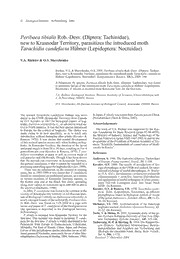
Peribaea tibialis Rob.-Desv. (Diptera: Tachinidae), new to Krasnodar Territory, parasitizes the introduced moth Tarachidia candefacta Hübner (Lepidoptera: Noctuidae) PDF
Preview Peribaea tibialis Rob.-Desv. (Diptera: Tachinidae), new to Krasnodar Territory, parasitizes the introduced moth Tarachidia candefacta Hübner (Lepidoptera: Noctuidae)
© Zoological Institute, St.Petersburg, 2005 Peribaea tibialis Rob.-Desv. (Diptera: Tachinidae), new to Krasnodar Territory, parasitizes the introduced moth Tarachidia candefacta Hübner (Lepidoptera: Noctuidae) V.A. Richter & O.S. Shevchenko Richter, V.A. & Shevchenko, O.S. 2005. Peribaea tibialis Rob.-Desv. (Diptera: Tachini- dae), new to Krasnodar Territory, parasitizes the introduced moth Tarachidia candefacta Hübner (Lepidoptera: Noctuidae). Zoosystematica Rossica, 13(2), 2004: 246. A Palaearctic fly species, Peribaea tibialis Rob.-Desv. (Diptera: Tachinidae), was found to parasitize larvae of the introduced moth Tarachidia candefacta Hübner (Lepidoptera: Noctuidae). P. tibialis is recorded from Krasnodar Terr. for the first time. V.A. Richter, Zoological Institute, Russian Academy of Sciences, Universitetskaya nab. 1, St.Petersburg 199034, Russia. O.S. Shevchenko, All-Russian Institute of Biological Control, Krasnodar 350039, Russia. The noctuid Tarachidia candefacta Hübner was intro- In Japan, P. tibialis was reared from Furcula furcula Clerck duced to the USSR (Krasnodar Territory) from Canada (Notodontidae) (Tachi & Shima, 2002). by O.V. Kovalev in 1967 for biological control of hog- brake, Ambrosia artemisifolia L., an adventive weed na- Acknowledgements tive to North America. It was the first species introduced The work of V.A. Richter was supported by the Rus- to Europe for the control of hogbrake. The choice was sian Foundation for Basic Research (grant 02-04-4858), made owing to its host specificity, so as to reach safe the Ministry of Industry, Science and Technology of the introduction without damaging other plants (Kovalev & Russian Federation (grant NSH-1667.2003.4) and by the Runeva, 1970). It was shown that normal development programme of the Presidium of Russian Academy of Sci- of this noctuid species occurs only when feeding on hog- ences “Scientific fundamentals of conservation of biodi- brake. In Krasnodar Territory, the duration of the larval versity in Russia”. and pupal stages is from 26 to 34 days, resulting in 3 or 4 generations per year (Kovalev & Runeva, 1970). T. can- References defacta overwinters as pupa in soil, in cocoon made of soil particles and silk threads. Though it has been shown Andersen, S. 1996. The Siphonini (Diptera: Tachinidae) that the noctuid can overwinter in Krasnodar Territory, of Europe. Fauna entomol. Scand., 33: 1-148. the general conclusion is that it cannot be regarded as a Kovalev, O.V. 1989. The results of introduction of for- promising controlling agent for hogbrake (Kovalev, 1989). eign phytophages in the USSR and outlook for inter- There was no information on the noctuid in ensuing national exchange of useful phytophages. In: Scarla- years, but in 1995-1998 it was found that T. candefacta to, O.A. (Ed.). Introduktsiya i primenenie poleznykh should be considered an established species, as it occurs chlenistonogikh v zashchite rasteniy [Introduction in various localities of Krasnodar Territory, namely, in and application of useful arthropods in plant protec- the Kuban area and at the Black Sea shore, spreading tion]: 162-168. Leningrad: Zool. Inst. Akad. Nauk along river valleys to mountains up to 600-800 m above SSSR. (In Russian). the sea level (Shchurov, 1998). Kovalev, O.V. & Runeva, T.D. 1970. Tarachidia cande- In 2004, T. candefacta was found to be common in the facta Hübn. (Lepidoptera, Noctuidae), an efficient vicinity of Krasnodar (the territory of All-Russian Insti- phytophagous insect in biological control of weeds tute of Biological Control), on Ambrosia artemisifolia. A of the genus Ambrosia L. Entomol. Obozr., 49(1): 23- newly emerged female of the tachinid fly Peribaea tibia- 36.(In Russian). lis Rob.-Desv. was found on 5.IX.2004 in a cage with Shchurov, V.I. 1998. Acclimatization of the American larvae and pupae of T. candefacta of the third generation hogbrake noctuid. Zashchita i Karantin Rasteniy, 12: (the specimen is deposited in the Zoological Institute, 31-32. (In Russian). St.Petersburg). Tachi, T. & Shima, H. 2002. Systematic study of the ge- P. tibialis is recorded from Krasnodar Territory for the nus Peribaea Robineau-Desvoidy of East Asia (Dip- first time. This tachinid was found to parasitize T. cande- tera: Tachinidae). Tijdschr. Entomol., 145: 115-144. facta for the first time. P. tibialis is widely distributed in the Tschorsnig, H.-P. & Herting, B. 1994. Die Raupenflie- Palaearctic from Europe to Transcaucasia, Uzbekistan, gen (Diptera: Tachinidae) Mitteleuropas: Bestim- Mongolia, Far East of Russia, China, Japan and Burma. mungstabellen und Angaben zur Verbreitung und Larvae of this polyphagous species parasitize larvae of dif- Ökologie der einzelnen Arten. Stuttg. Beitr. Naturk., ferent genera of Noctuidae, more rarely larvae of other Mac- Ser. A, 506: 1-170. rolepidoptera (Tschorsnig & Herting, 1994; Andersen, 1996). Received 27 December 2004
